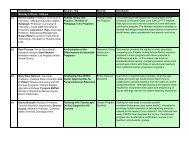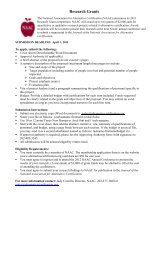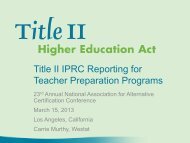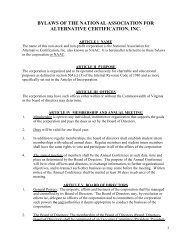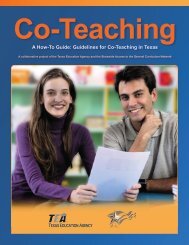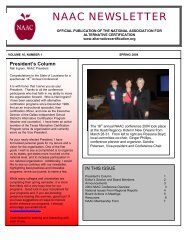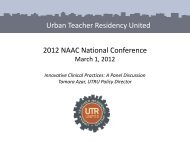Planning Behavior Expectations for an Instructional Activity
Planning Behavior Expectations for an Instructional Activity
Planning Behavior Expectations for an Instructional Activity
You also want an ePaper? Increase the reach of your titles
YUMPU automatically turns print PDFs into web optimized ePapers that Google loves.
<strong>Pl<strong>an</strong>ning</strong> <strong>Behavior</strong> <strong>Expectations</strong> <strong>for</strong> <strong>an</strong> <strong>Instructional</strong> <strong>Activity</strong>adapted from CHAMPs: A Proactive <strong>an</strong>d Positive Approach to Classroom M<strong>an</strong>agementby R<strong>an</strong>dy Sprick, PhD, Mickey Garrison, PhD, <strong>an</strong>d Lisa M. Howard, MSYour Name:Date:<strong>Instructional</strong> <strong>Activity</strong> Addressed:Conversation: C<strong>an</strong> the students engage in conversation with each other or you during this partof the lesson? If yes, with whom? About what? How m<strong>an</strong>y students c<strong>an</strong> be involved in a singleconversation? How long c<strong>an</strong> the conversation last?Help: How will the students let you know they do not underst<strong>an</strong>d what you w<strong>an</strong>t them to do?How c<strong>an</strong> they get your attention? How do students get questions <strong>an</strong>swered? If students have towait <strong>for</strong> help, what should they do while waiting?<strong>Activity</strong>: What is the expected end product of this part of this lesson? What will the productlook like?Movement: C<strong>an</strong> the students get out of their seats during this part of the lesson? If yes, do theyneed permission? If yes, how do they get permission? What c<strong>an</strong> they get out of their seat to do(e.g. pencil, drink, restroom, h<strong>an</strong>d in/pick up materials)?Participation: What behaviors demonstrate that students are participating fully <strong>an</strong>dresponsibly? What behavior demonstrates a student is not participating or otherwise activelyengaged? What should a student do if they finish early?________________________________________________________________________________________________________________________________________________________________________Copyright©2008, Education Service Center Region XIII
________________________________________________________________________________________________________________________________________________________________________Copyright©2008, Education Service Center Region XIII
Classroom M<strong>an</strong>agement Pl<strong>an</strong> (Draft)Name:Date:Basic but import<strong>an</strong>t classroom procedures I pl<strong>an</strong> to develop, teach <strong>an</strong>drein<strong>for</strong>ce the first week or so of school(developed from “Procedures: <strong>Pl<strong>an</strong>ning</strong> <strong>for</strong> the First Month”):My procedure <strong>for</strong> securing my students’ attention will be:1.2.3.________________________________________________________________________________________________________________________________________________________________________Copyright©2008, Education Service Center Region XIII
4.5.Strategies I pl<strong>an</strong> to use to teach classroom expectations <strong>for</strong> my procedures:1.2.3.4.1.Strategies I pl<strong>an</strong> to use to check <strong>for</strong> underst<strong>an</strong>ding of <strong>an</strong>dmonitor the behavior expectations I teach:2.3.4.________________________________________________________________________________________________________________________________________________________________________Copyright©2008, Education Service Center Region XIII
Strategies I pl<strong>an</strong> to implement to increase the motivation:a. Of <strong>an</strong> entire class, period or group:b. Of individual students:1.Probable classroom rules:2.3.4.5.1.“Deterrent” (corrective) techniques I pl<strong>an</strong> to implement:2.3.4.5.‣Menu of consequences I pl<strong>an</strong> to implement:________________________________________________________________________________________________________________________________________________________________________Copyright©2008, Education Service Center Region XIII
‣‣‣‣‣‣‣‣________________________________________________________________________________________________________________________________________________________________________Copyright©2008, Education Service Center Region XIII
“I’ve come to a frightening conclusion that Iam the decisive element in the classroom. It’s mypersonal approach that creates the climate. It’s mydaily mood that makes the weather. As a teacher, Ipossess a tremendous power to make a child’s lifemiserable or joyous. I c<strong>an</strong> be a tool of torture or <strong>an</strong>instrument of inspiration. I c<strong>an</strong> humiliate orhumor, hurt or heal. In all situations, it is myresponse that decides whether a crisis will beescalated or de-escalated <strong>an</strong>d a child hum<strong>an</strong>ized ordehum<strong>an</strong>ized.-Haim Ginott________________________________________________________________________________________________________________________________________________________________________Copyright©2008, Education Service Center Region XIII
Thinking like a <strong>Behavior</strong> SpecialistEffective discipline does not come from the quick mastery of techniquesor the implementation of a packaged method. Effective discipline comesfrom the heart <strong>an</strong>d soul of the teacher.It comes from the belief that teaching students to takeresponsibility <strong>for</strong> their behavior is as much the "job" of the teacher asteaching history or math <strong>an</strong>d more import<strong>an</strong>t th<strong>an</strong> simply en<strong>for</strong>cing therules.It comes from the belief that most students do the best they c<strong>an</strong>, m<strong>an</strong>y inwhat they feel is <strong>an</strong> adverse environment. It comes from the belief thatall students need hope. It comes from the positive energy of the teacher.Only within the framework of the teacher's internal strength <strong>an</strong>dthe development of a hopeful <strong>an</strong>d caring classroom environment c<strong>an</strong> adiscipline pl<strong>an</strong> be effective.From Discipline with Dignityby Richard Curwin & All<strong>an</strong> Mendler________________________________________________________________________________________________________________________________________________________________________Copyright©2008, Education Service Center Region XIII
EmailTo: Theresajones@texaspublicschool.netFrom:Subject:Message:________________________________________________________________________________________________________________________________________________________________________Copyright©2008, Education Service Center Region XIII
Action Pl<strong>an</strong>Name:Date:Suggested Strategyto be ImplementedNovice Teacher Responsibilities<strong>for</strong> ImplementationWhen ShouldStrategybe Implemented?________________________________________________________________________________________________________________________________________________________________________Copyright©2008, Education Service Center Region XIII
Classroom Environment: Enduring Underst<strong>an</strong>dings NotesEnduring Underst<strong>an</strong>ding #1Thoughts, insight, <strong>an</strong>d questions about this underst<strong>an</strong>ding:Concepts about <strong>an</strong>d strategies to use when implementing thisunderst<strong>an</strong>ding:Enduring Underst<strong>an</strong>ding #2Thoughts, insight, <strong>an</strong>d questions about this underst<strong>an</strong>ding:Concepts about <strong>an</strong>d strategies to use when implementing thisunderst<strong>an</strong>ding:
Enduring Underst<strong>an</strong>ding #3Thoughts, insight, <strong>an</strong>d questions about this underst<strong>an</strong>ding:Concepts about <strong>an</strong>d strategies to use when implementing thisunderst<strong>an</strong>ding:
Classroom EnvironmentPer<strong>for</strong>m<strong>an</strong>ce Task: Mentoring a Novice TeacherBasic In<strong>for</strong>mationPer<strong>for</strong>m<strong>an</strong>ce Task Description: Develop a behavior m<strong>an</strong>agement Action Pl<strong>an</strong> <strong>an</strong>dcompose <strong>an</strong> email explaining the rationale <strong>for</strong> <strong>an</strong>d implementation of the Action Pl<strong>an</strong>Task due date: ___________________________________________________Your role: You are the assigned mentor to a novice teacher, Theresa Jones. Theresahas asked <strong>for</strong> your help in developing <strong>an</strong>d improving her classroom m<strong>an</strong>agement skills.Purpose of task: Through this task, you will provide evidence of your underst<strong>an</strong>ding of<strong>an</strong>d ability to implement strategies aligned to this unit’s enduring underst<strong>an</strong>dings:- <strong>Behavior</strong> is Communication- The Teacher is the Decisive Element, <strong>an</strong>d- <strong>Behavior</strong> M<strong>an</strong>agement is a Content AreaDirections <strong>for</strong> per<strong>for</strong>m<strong>an</strong>ce task: After <strong>an</strong>alyzing <strong>an</strong>ecdotal notes taken in <strong>an</strong>observation of Theresa’s classroom <strong>an</strong>d utilizing the knowledge <strong>an</strong>d skills learned in thisunit, you will:1) Prepare <strong>an</strong> Action Pl<strong>an</strong> <strong>for</strong> Theresa to follow in improving her behaviorm<strong>an</strong>agement skills.2) Prepare <strong>an</strong> email (letter) to send to Theresa explaining the Action Pl<strong>an</strong> goals <strong>an</strong>dproviding rationales <strong>for</strong> the goals you developed.Documents needed in preparation <strong>for</strong> task:- Per<strong>for</strong>m<strong>an</strong>ce Task Documento Basic In<strong>for</strong>mationo Background In<strong>for</strong>mationo Anecdotal Noteso Per<strong>for</strong>m<strong>an</strong>ce Criteria Checklist- E-mail <strong>an</strong>d Action Pl<strong>an</strong> TemplatePer<strong>for</strong>m<strong>an</strong>ce <strong>Expectations</strong> <strong>for</strong> the Action Pl<strong>an</strong>:• Thoroughly completed Action Pl<strong>an</strong>, using template provided• A minimum of 3 strategies selected• Expl<strong>an</strong>ation of each strategy, including HOW <strong>an</strong>d WHEN it should beimplemented• Strategies selected demonstrate <strong>an</strong>alysis of in<strong>for</strong>mation provided• Clear connection to <strong>an</strong>d evidence of deep underst<strong>an</strong>ding of the unit’s EnduringUnderst<strong>an</strong>dings• Typed in 12 point Times New Rom<strong>an</strong> font with evidence of mastery ofconventions of EnglishRegion XIII – Online Learning Page 1 4/18/2006ECP: Classroom Environment , Classroom Environment <strong>Behavior</strong> is Communication, What is the Student Communicating?Collecting <strong>Behavior</strong>al Data. PDF
Per<strong>for</strong>m<strong>an</strong>ce <strong>Expectations</strong> <strong>for</strong> the E-mail:• Empathy <strong>an</strong>d support displayed toward Theresa, as a novice teacher, includingevidence demonstrating underst<strong>an</strong>ding of the typical struggles of a first yearteacher <strong>an</strong>d reassur<strong>an</strong>ce of the value of your support in h<strong>an</strong>dling such struggles• Expl<strong>an</strong>ations of at least two behavior m<strong>an</strong>agement techniques Theresa iscurrently demonstrating use of <strong>an</strong>d rationale <strong>for</strong> why these techniques are useful• Thorough expl<strong>an</strong>ation of at least three new behavior m<strong>an</strong>agement strategies tobe implemented• Clear rationale <strong>for</strong> each selected strategy based on concrete evidence fromartifacts provided• Persuasive reasoning of WHY each suggested strategy should be implementedwhich reflects deep underst<strong>an</strong>ding of each of the three Enduring Underst<strong>an</strong>dings• Use of professional l<strong>an</strong>guage <strong>an</strong>d proficient written expression skills• Typed in 12 point Times New Rom<strong>an</strong> font with evidence of mastery ofconventions of EnglishAdditional guidelines:• Develop your action pl<strong>an</strong> <strong>an</strong>d email so that you address such issues as:o What is Theresa doing well?o What is she struggling with?o What strategies do you suggest <strong>an</strong>d how specifically should sheimplement those strategies?o How should Theresa prioritize her time in implementing the strategies?• Keep in mind that typically, a mentor would have a number of conferences withhis/her mentee in order to develop <strong>an</strong>d explain <strong>an</strong> action pl<strong>an</strong>. In thisassignment, you are expected to demonstrate your deep underst<strong>an</strong>ding of thecontent you have learned through your skillful choice of action pl<strong>an</strong>goals/strategies <strong>an</strong>d through your detailed development of <strong>an</strong> email (letter)containing your conceptual <strong>an</strong>d practical underst<strong>an</strong>ding of the most import<strong>an</strong>tstrategies Theresa should implement in order to improve her behaviorm<strong>an</strong>agement skills.Artifacts created by you <strong>an</strong>d submitted to course facilitator <strong>for</strong> evaluation:- E-mail to Theresa- Action Pl<strong>an</strong>Method of evaluation:- Criteria ChecklistRegion XIII – Online Learning Page 2 4/18/2006ECP: Classroom Environment , Classroom Environment <strong>Behavior</strong> is Communication, What is the Student Communicating?Collecting <strong>Behavior</strong>al Data. PDF
Classroom EnvironmentPer<strong>for</strong>m<strong>an</strong>ce Task: Mentoring a Novice TeacherBackground In<strong>for</strong>mationTheresa Jones is a beginning teacher <strong>an</strong>d it is late September of her first semester ofteaching. She has just dismissed her students at the end of the day. As she reflects onthe events of today’s class, she decides to compose <strong>an</strong> email to her mentor (YOU!):From: Theresajones@texaspublicschool.netTo: Theresasmentor@texaspublicschool.netSubject: Request <strong>for</strong> adviceDear Mentor,I’ve finally decided that I’m at the point where I could really use some help! I am havinga hard time with behavior in my class. Every day is a struggle – some students aredisruptive (I had to send one to the office today <strong>for</strong> prof<strong>an</strong>ity) while others just make ithard <strong>for</strong> me to actually get <strong>an</strong>y teaching done. C<strong>an</strong> you give me some suggestions onthings I c<strong>an</strong> do to improve behavior in my class? I’m ready to listen!Sincerely,TheresaAfter exch<strong>an</strong>ging emails with Theresa, you arr<strong>an</strong>ge <strong>an</strong> observation in which you watchTheresa’s afternoon reading class. See “Anecdotal Notes” <strong>for</strong> a description of what youobserve in Theresa’s class.Region XIII – Online Learning Page 3 4/18/2006ECP: Classroom Environment , Classroom Environment <strong>Behavior</strong> is Communication, What is the Student Communicating?Collecting <strong>Behavior</strong>al Data. PDF
Classroom EnvironmentPer<strong>for</strong>m<strong>an</strong>ce Task: Mentoring a Novice TeacherAnecdotal NotesIt is afternoon, <strong>an</strong>d students are arriving to reading class from lunch. Theresa st<strong>an</strong>dsnear the door as students enter <strong>an</strong>d is surrounded by students asking questions <strong>an</strong>dseeking her attention. After <strong>an</strong>swering a few questions, Theresa says, “Alrighteveryone, settle down. Go to your seats <strong>an</strong>d get started.”The class schedule is posted on the board:12:35 – Enter <strong>an</strong>d read silently12:55 – Reading lesson: Main Idea1:20 – Dismissal12:40: Theresa sits at her desk <strong>an</strong>d turns on a timer. Some students have books out<strong>an</strong>d are looking at the books. Other students are flipping pages. One student isdrawing a picture <strong>an</strong>d several students are st<strong>an</strong>ding near the bookshelf talking.Theresa looks around the room <strong>an</strong>d calls out from her desk, “I need to see everyonereading. Tomio, if you don’t sit down you will owe me a minute after class. Tomiomakes a response that isn’t underst<strong>an</strong>dable. Theresa replies, “What was that?” Tomioraises his voice, “I said you c<strong>an</strong>’t make me!” Theresa responds by st<strong>an</strong>ding up <strong>an</strong>dquickly walking over to the student, “I c<strong>an</strong> <strong>an</strong>d I will. In fact, you’re out of here!”Theresa writes <strong>an</strong> office referral <strong>an</strong>d sends Tomio out of the room with the referral.12:45: All students are seated. Some flip though books, quickly turning pages <strong>an</strong>dothers appear to be reading. One student gets up 3 times to go to the bookshelf <strong>an</strong>dreturns with a different book. When two students talk, Theresa says, “SHHH!” Twostudents in the back pass a note back <strong>an</strong>d <strong>for</strong>th when Theresa is not looking. Sitting ather desk, Theresa flips through some professional materials. One student gets up <strong>an</strong>dwalks over to Theresa’s desk to ask a question, which she <strong>an</strong>swers. When <strong>an</strong>otherstudent gets up <strong>an</strong>d goes to the teacher’s desk, Theresa says, “Return to your seat.Remember this is silent reading time.”Region XIII – Online Learning Page 4 4/18/2006ECP: Classroom Environment , Classroom Environment <strong>Behavior</strong> is Communication, What is the Student Communicating?Collecting <strong>Behavior</strong>al Data. PDF
12:55: A timer goes off <strong>an</strong>d Theresa says, “Okay. Everyone put away your books. Sheturns on the overhead <strong>an</strong>d reads the directions <strong>for</strong> a tr<strong>an</strong>sparency on main idea.Theresa h<strong>an</strong>ds out a reading passage worksheet <strong>an</strong>d tells everyone to read thepassage. After several minutes she asks questions like, “What is the main idea ofparagraph 2?” Some students raise their h<strong>an</strong>ds <strong>an</strong>d wave them wildly, saying “I know! Iknow!” Others raise their h<strong>an</strong>d <strong>an</strong>d wait silently. Some students don’t raise their h<strong>an</strong>dsat all. One student calls out <strong>an</strong> <strong>an</strong>swer. Theresa says, “That’s right Kelly, but next timeraise your h<strong>an</strong>d.” This routine is repeated as Theresa asks more questions about thepassage.1:05: Theresa h<strong>an</strong>ds out a new worksheet <strong>an</strong>d says, “I w<strong>an</strong>t you to do this one on yourown.” She walks around the room as students get started. One student asks to go tothe restroom. Theresa responds, “Not right now.” Another asks to go get water, <strong>an</strong>dthen a third chimes in, “C<strong>an</strong> I go, too?” Theresa sighs, “Alright, but go one at a time.”One student raises his h<strong>an</strong>d <strong>an</strong>d asks, “C<strong>an</strong> I work with a partner?” Theresa responds,“Oh, okay – if that is what you need to do to do a good job.” As Theresa walks around,she offers to help a student who hasn’t gotten started.1:10 “I’m finished!” one student yells out. Theresa responds, “If you’re finished, you c<strong>an</strong>read or just sit quietly at your desk” At this time, Tomio returns back into theclassroom. Theresa says, “Tomio, we’re working on a reading passage. Get started<strong>an</strong>d I’ll come check on you in a minute. Tomio takes the paper from Theresa <strong>an</strong>d goesto his seat but doesn’t get started.As students continue to finish, the noise level in the room gets higher. Theresa goesaround the room to help students who aren’t finished <strong>an</strong>d tries to check the work ofstudents who say they are finished.When the bell rings <strong>for</strong> the end of the period, students immediately get up <strong>an</strong>d startmoving toward the door. Theresa yells out, “Hold on – let me give you your homework!Tomio <strong>an</strong>d a few others leave the room be<strong>for</strong>e Theresa gets to the door with thehomework <strong>an</strong>d passes it out to those who are still in the room.Once the students are gone, Theresa goes back to her desk. You reassure her that shedid the right thing by asking <strong>for</strong> some advice <strong>an</strong>d that there are some things that shec<strong>an</strong> do to improve the climate <strong>an</strong>d behaviors in her classroom. You end the discussionby letting her know that you will create <strong>an</strong> Action Pl<strong>an</strong> <strong>for</strong> her to follow, as well as <strong>an</strong>email explaining the Action Pl<strong>an</strong>. Theresa sees you out the door by saying, “Th<strong>an</strong>ks <strong>for</strong>your help! I c<strong>an</strong>’t wait to read the suggestions you have <strong>for</strong> me!”Region XIII – Online Learning Page 5 4/18/2006ECP: Classroom Environment , Classroom Environment <strong>Behavior</strong> is Communication, What is the Student Communicating?Collecting <strong>Behavior</strong>al Data. PDF
Classroom EnvironmentPer<strong>for</strong>m<strong>an</strong>ce Task: Criteria ChecklistBelow is a list of criteria <strong>for</strong> excellence <strong>for</strong> the per<strong>for</strong>m<strong>an</strong>ce task of“Classroom Environment: Mentoring a Novice Teacher.” Each criterionshould be considered <strong>an</strong>d included in your final product as evidence of yourcompetency in the knowledge <strong>an</strong>d skills modeled <strong>an</strong>d practiced within thisunit. This document will be used by your facilitator when reviewing the“Email” <strong>an</strong>d “Action Pl<strong>an</strong>” you submit.Action Pl<strong>an</strong>: Thoroughly completed with a minimum of 3 strategies selected A clear expl<strong>an</strong>ation of how to implement each strategy Consistent use of professional l<strong>an</strong>guage <strong>an</strong>d proficient writtenexpression skills Typed in 12 pt Times New Rom<strong>an</strong> fontE-mail: Evidence of underst<strong>an</strong>ding of your role as a supportive professional Expl<strong>an</strong>ation of at least 2 techniques successfully being implemented <strong>an</strong>drationale <strong>for</strong> continued use Clear rationale <strong>for</strong> each new suggested strategy based on concreteevidence from the data provided Persuasive reasoning of why each selected suggested strategy reflectsdeep underst<strong>an</strong>ding of each of the three Enduring Underst<strong>an</strong>dings Consistent use of professional l<strong>an</strong>guage <strong>an</strong>d proficient writtenexpression skills Typed in 12 pt Times New Rom<strong>an</strong> fontRegion XIII – Online Learning Page 6 4/18/2006ECP: Classroom Environment , Classroom Environment <strong>Behavior</strong> is Communication, What is the Student Communicating?Collecting <strong>Behavior</strong>al Data. PDF



